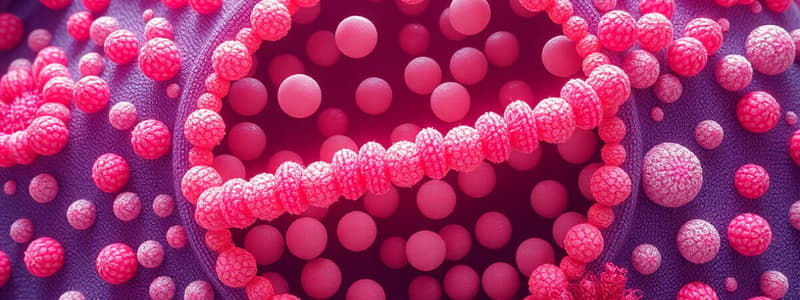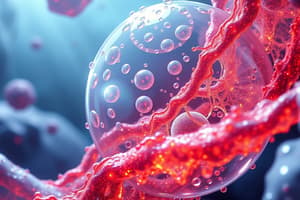Podcast
Questions and Answers
What is the primary function of the cell membrane?
What is the primary function of the cell membrane?
- Regulates materials entering and exiting the cell (correct)
- Produces energy for the cell
- Stores genetic material
- Synthesizes ribosomes
Which of the following components makes up the largest percentage of the cell membrane?
Which of the following components makes up the largest percentage of the cell membrane?
- Phospholipids (correct)
- Carbohydrates
- Cholesterol
- Proteins
What is the primary role of the nucleolus within the nucleus?
What is the primary role of the nucleolus within the nucleus?
- Assembles ribosomes (correct)
- Synthesizes lipids
- Controls cell division
- Regulates DNA replication
What is diffusion?
What is diffusion?
Which cell type is described as large, thin, flat, and containing a rounded nucleus?
Which cell type is described as large, thin, flat, and containing a rounded nucleus?
What percentage of the cell membrane is composed of proteins?
What percentage of the cell membrane is composed of proteins?
Which transportation process does NOT involve water?
Which transportation process does NOT involve water?
Which function is NOT associated with the cell membrane?
Which function is NOT associated with the cell membrane?
How are the layers of the cell membrane primarily arranged?
How are the layers of the cell membrane primarily arranged?
Which term refers to the movement of water through a semi-permeable membrane?
Which term refers to the movement of water through a semi-permeable membrane?
What process describes the movement of solvent molecules from a region of lower concentration to one of higher concentration?
What process describes the movement of solvent molecules from a region of lower concentration to one of higher concentration?
Which of the following factors does NOT affect the rate of diffusion?
Which of the following factors does NOT affect the rate of diffusion?
What term refers to the separation of molecules based on size through a semipermeable membrane?
What term refers to the separation of molecules based on size through a semipermeable membrane?
During osmosis, what happens when equal concentrations are reached on both sides of the membrane?
During osmosis, what happens when equal concentrations are reached on both sides of the membrane?
Which test is used to identify the presence of amino acids?
Which test is used to identify the presence of amino acids?
What results from the Biuret test indicate the presence of compounds with two or more peptide bonds?
What results from the Biuret test indicate the presence of compounds with two or more peptide bonds?
Which solution has the same osmotic pressure as another solution, particularly within a cell?
Which solution has the same osmotic pressure as another solution, particularly within a cell?
What compound observed in the Biuret test indicates a higher number of peptide bonds?
What compound observed in the Biuret test indicates a higher number of peptide bonds?
In which scenario would the movement of solvent molecules during osmosis stop?
In which scenario would the movement of solvent molecules during osmosis stop?
Which of the following statements about dialysis is accurate?
Which of the following statements about dialysis is accurate?
What characterizes a hypotonic solution?
What characterizes a hypotonic solution?
Which of the following actions best describes hydrolysis?
Which of the following actions best describes hydrolysis?
What is the effect of soap on the surface tension of water?
What is the effect of soap on the surface tension of water?
Which of the following substances is known to increase surface tension?
Which of the following substances is known to increase surface tension?
Surface tension in liquids is primarily caused by which of the following?
Surface tension in liquids is primarily caused by which of the following?
What happens to the surface tension when soap is added to water?
What happens to the surface tension when soap is added to water?
A hypertonic solution can be defined as:
A hypertonic solution can be defined as:
Which statement about water's surface tension is correct?
Which statement about water's surface tension is correct?
An example of a solute that lowers surface tension is:
An example of a solute that lowers surface tension is:
What occurs to a cell placed in a hypotonic solution?
What occurs to a cell placed in a hypotonic solution?
Flashcards are hidden until you start studying
Study Notes
Cell Membrane
- Also known as the Plasma Membrane, the cell membrane is semi-permeable and selective in its functions.
- Composed of 55% proteins, 25% phospholipids, 13% cholesterol, 4% other lipids, and 3% carbohydrates.
- Regulates the entry and exit of materials, crucial for cell function and biosynthesis.
Squamous Cell
- Characterized by being large, thin, and flat, containing a rounded nucleus.
- Functions primarily in absorption and transport of materials, important in areas like the kidneys and alveoli of the lungs.
- Plays significant roles in processes such as diffusion, osmosis, and filtration.
Nucleus
- Acts as the control center of the cell, regulating the actions of DNA and RNA.
Nucleolus
- Located within the nucleus, the nucleolus assembles ribosomes and is the site of ribosomal biogenesis.
Transport Systems Across the Membrane
- Various mechanisms include diffusion, osmosis, dialysis, hydrolysis, and surface tension.
Diffusion
- The movement of molecules from higher to lower concentration until equilibrium is achieved.
- Rate influenced by concentration difference, size and shape of molecules, and temperature.
Osmosis
- Movement of solvent molecules from lower to higher concentration through a semi-permeable membrane.
- Equilibrium occurs when concentrations equalize or pressure is applied.
Dialysis
- A separation process based on the size of molecules, allowing small solutes to pass while retaining larger solutes, typically preventing protein passage.
Dialysis Test Procedures
- Test for Chlorides:
- Reacts with AgNO3 to produce a white precipitate (AgCl).
- Biuret Test for Peptide Bonds:
- Positive result indicated by a rose-violet-purple color; deeper colors indicate more peptide bonds.
- Ninhydrin Test for Amino Acids:
- Positive result manifests as blue to violet color (Ruhemann's purple), except for proline which yields a yellow color.
Types of Solutions
- Isotonic Solution: Equivalent osmotic pressure as body fluids, maintaining cell integrity.
- Hypotonic Solution: Lower osmotic pressure compared to body fluids, can cause cells to swell.
- Hypertonic Solution: Higher osmotic pressure than body fluids, can lead to cell shrinkage due to water loss.
Hydrolysis
- A chemical reaction using water to break chemical bonds in a substance.
Surface Tension
- Results from the cohesive forces among liquid molecules at the surface, creating a membrane-like property; pure water has high surface tension.
- Inorganic salts increase surface tension while soaps and detergents decrease it, affecting how objects interact with water surfaces.
Studying That Suits You
Use AI to generate personalized quizzes and flashcards to suit your learning preferences.




